DLP-Projector Double Review:
Mitsubishi HC3100 and HC1100
Two successors to the well-known HC3000
fight for first place
A year ago, Mitsubishi premiered the HC3000 at the IFA (Internationalen Funk Ausstellung) in Berlin and started its successful run through Europe. Just in time for this year's IFA its successor is presented, the HD3100 (ca. €2290,--). And with the new model its little brother is also introduced, under the model name HC1100 it is a slightly stripped and with this a more attractively priced (ca. €1499,--) version of the HC3100.

The new Mitsubishi models
On the outside the brothers can hardly be separated from each other, only the white ring around the optics and the bright stripe on top of the machine set the twins apart (HC1100 on the left). We were fortunate to have both models in our test lab at the same time, and submitted them to our usual, conscientious test procedure. In this Special review we will describe the technical innovations of the HC3100 compared to its predecessor, as well as the differences compared to the HC1100.
We refer in advance to our test criteria, which are described in detail in our Know How Special: "Projectors / Plasma TV's - Quality aspects".
1. Equipment and Technology (Know How Link here)
This year also the DLP projectors from Mitsubishi have not changed optically. Both the HC1100 and the HC3100 use the same compact chassis which premiered with the HC900 a couple of years ago.

Above: the HC3100, below: the HC1100

A new design would surely have provided something new, but the appealing housing was well received with customers of the HC3000, which makes the decision to use the housing for one more generation understandable. However, the manufacturer could have been a little more creative with the choice of colors, in white the model would have fitted even better optically in most living rooms.
1.1 Technology (Know How Link here)
Technically the HC3100 offers some substantial changes, which are however difficult to "unmask". Particularly interesting innovations are a special color wheel with color segments which have been optimized to the necessary D65 color temperature and can now be operated at either four- or five-fold speed. Furthermore the picture is now produced with a newest generation DC3 (DarkChip) DMD, which also enables loss-free representation of XGA computer signals with its resolution of 1280 x 768 pixels.
The HC1100 is somewhat less luxurious, as it operates with "only" a 1280 x 720 DC2 chip. Therefore, less picture contrast is to be expected compared to the HC3100. In addition it does not have an adaptive iris. The optimized D65 color wheel is used for coloring the picture.
As always we took a look inside the projector, to provide you with an understandable technical overview of the functioning principles of the machine. Upon opening the machine, it strongly resembles the inner layout of the HC3000, differences are not visible at first or even second glance.

The projector is well shielded on the inside

Even the main circuit board has not changed much. This was not necessary, because the signal processing used in the HC3000 was one of the newest generation, the DDP3020. In our HC3000 review it convinced us with few digital artifacts and good color correctness.

The compact main board takes over the entire machine operation

The ventilation system has also remained unchanged, which with regard to the low noise produced by the machine was not a necessity. Distributed over the entire machine, three partly decoupled fans provide for the proper cooling of both electronics and lamp. The HC3100 does not acoustically annoy movie operation in any way.
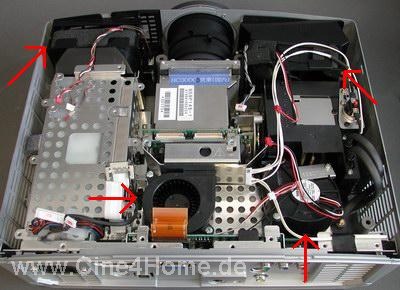
Three high performance fans, in part decoupled with foam
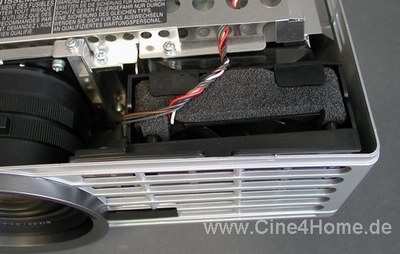
For extra dust protection the additional filter is provided with the projector, which can be attached to the projector with a turn of the wrist. Its predecessors have proved to be extremely resistant to dust with it.
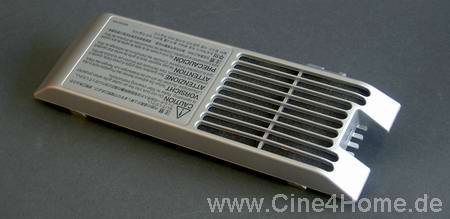
The air vents for the hot air are positioned at the left and the front with both the HC3100 and the HC1100. The user must make sure there is enough distance between the projector and other furniture and\or devices.
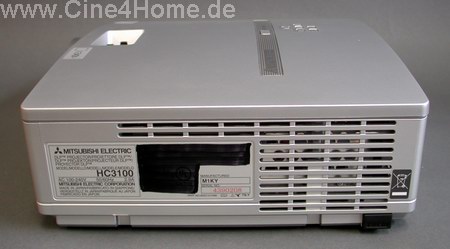
Air vents all around
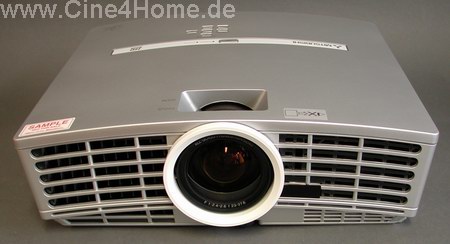
The lamp module consists of a 200 Watt UHP lamp, which with a life expectancy of up to 3000 hours operates very economically. A user can have the pleasure of viewing up to 2000 movies before a replacement is needed.
After the light has left the lamp it directly reaches the 6-segment color wheel, which is hidden behind a black iris to minimize scattered light.
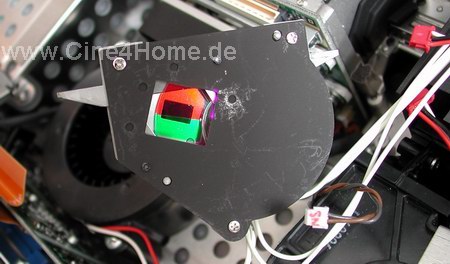
Black iris with color wheel behind it
And here the first technical innovation of the HC3100 can actually be seen: the color wheel is clearly different from that of the HC3000 model.
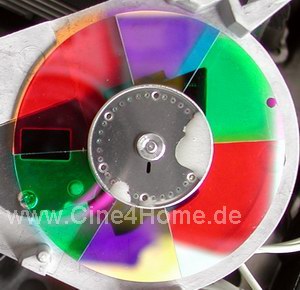
The Red segments have been enlarged again with the new wheel (see image above). The required space was taken from the Blue segments, which are now the smallest on the color wheel. This is an intelligent change, because from the factory the HC3000 exhibited a lack of Red and an excess of Blue. The new color wheel should improve the color balance. To reduce the rainbow effect, the color wheel can be set to five-fold speed in the Picture menu, but only with the HC3100 model. The HC1100 only offers quadruple speed of the color wheel, so a certain insensitiveness to rainbows must be present.
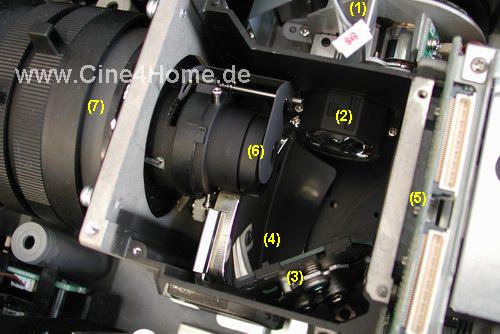
The light path after the color wheel has not changed in the HC3100: after passing the color wheel (1) the light passes a small optic (2) in the DMD chamber. Over a diagonal mirror (3) it is steered to (and this is something we have never seen with any other manufacturer) a parabolic reflector (4), and from there on the actual DMD chip (5). The picture is generated on the DMD, which consequently passes the adaptive iris (6) and is projected on the screen by the optics (7).
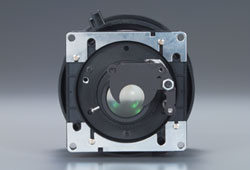
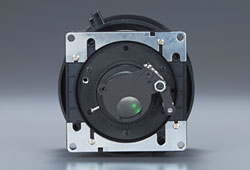
Adaptive iris opened (left) and closed (right)
With the adaptive iris the light efficiency, and with it black level, can be adjusted to personal taste, picture size and room conditions. However, only the HC3100 offers this, the HC1100 only contains a static iris, which means the black level can not be changed.
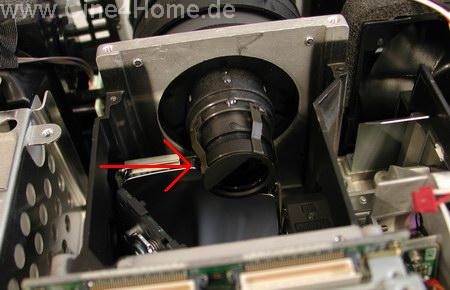
In the HC1100 a larger but static iris was installed
The last and substantial innovation in the optical design of the HC3100, the newest DarkChip 3 version of the 1280 x 768 DMD, is not visible to the naked eye unfortunately, because the tiny mirror miracles look almost exactly the same.
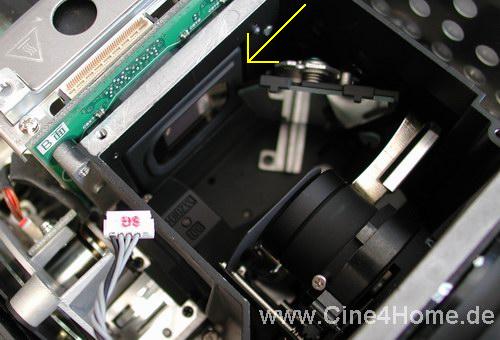
The DMD chip is positioned directly opposite the projection optics
In the HC1100 another version of the DVD chip is used; a more common DC2 1280 x 720 chip. But this chip is also capable of a remarkable picture quality.
Mitsubishi has also decided, as did Sanyo, to take an otherwise good model and improve on it. Regarding the technical structure this resulted in a solid, well though out and compact design, which does not show any weaknesses. It remains exciting to see how the "trimmed down" HC1100 will fare against the HC3100.
1.2 Connections / Signal types (Know How Link here)
Nothing has changed with regard to the connections of the machine. This is a little unfortunate, because we would have welcomed a second HDMI input in these coming HD age with all of its copy protection.

The connections are identical with the HC3100 and the HC1100, by the way. The red marker was not used here in favor of price.
The offered connection possibilities are not overdone, but every type of signal (480i/p, 576i/p, VGA, SVGA, XGA etc., 720p, 1080i in both 50Hz and 60Hz) has its own input (analog / digital). This is justified concerning the price range of the projector.
1.3 Setup (Know How Link here)
Nothing was changed with the new models regarding the placement characteristics. Unfortunately both the HC3100 as well as the HC1100 do not offer a mechanical lens shift. This means that the image height has to be adjusted by using an adjustable ceiling mount or of need be by tilting the projector.
Here, the higher native resolution of the HC3100 pays off: with video projection, only 720 of the 768 image lines are used according to the standard. The remaining 48 lines can be used as electronic Lens Shift, which a shifting range that is not to be neglected. The HC1100 unfortunately does not offer this luxury because of its 720 chip, the vertical offset is static here.
The limited zoom range has not changed with either of both models, but it is suitable for most room conditions.
Projection distance table "HC-3100 / 1100"
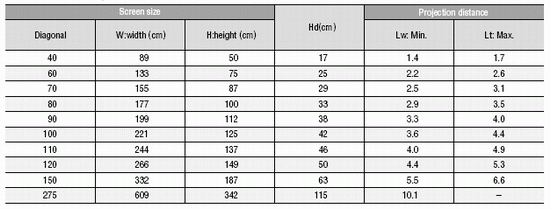
A prospective buyer should take a close look at the projection characteristics when planning his room, because the projector displays a certain "offset", i.e. the image is projected slightly tilted up / down (somewhat adjustable with the HC3100).
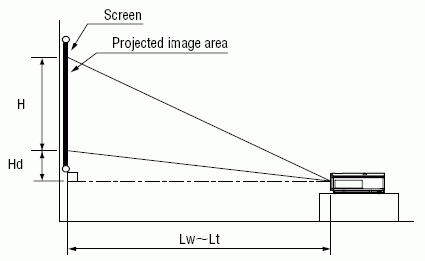
Vertical Offset
Once the projector is placed, sharpness and zoom are adjusted manually at the optics of the projector. The mechanics feel very high-quality and just heavy enough to allow a precise adjustment.
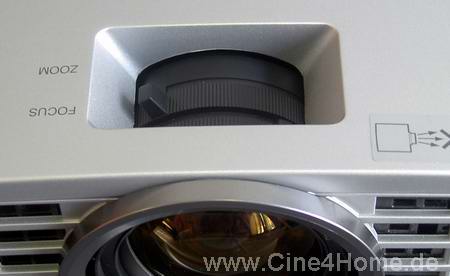
Adjustment rings of the HC3100
On the whole the projector is well suited for most living rooms, not in the least because of its compact dimensions. The flexible placement characteristics of current LCD projectors are not reached however. Because the offset of the projector is quite large, placement problems could occur in low cellar rooms for instance.
2. Operating the projector (Know How Link here)
Regarding the operation of the projector; the menu concept was retained, only some new functions were added. In the case of the HC3100 the remote control was greatly improved and now offers more comfort:
2.1 Remote Control
As we mentioned in our previous test, the HC3000 was supplied with a relatively economical remote control, like those that are supplied with many cheaper entry level projectors. To offer a little more luxury, the HC3100 is supplied with a larger and more elaborate remote control.


The remote control of the HC3100
The new remote control is very elegant optically (especially when the electric lighting is activated) and offers a good key structure. Even separate source selection is available. Equally good is the infra red transmitter, which does not exhibit any problems even over large ranges and angles.
The remote control supplied with the HC1100 is the smaller, more economical version of the HC3100 remote. It is not nearly as luxurious, but works equally well.

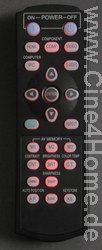
Remote control of the HC1100
The HC1100 remote control is very comfortable, can be electrically lit and
offers all relevant functions and buttons for direct source selection.
In case the remote control is not at hand, all basic operations can also be performed by the key pad located on the top side of the machine (with both models).
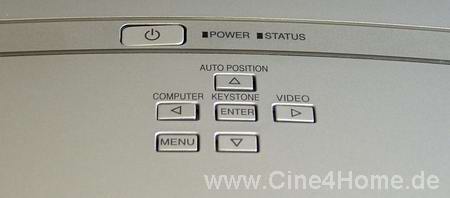
Control pad on the top side of the projector
2.2 Menus
As already mentioned the OnScreen menus of the HC3000 were kept as they were, only expanded with additional functions as needed.
All parameters are divided into four main categories, each marked by graphical symbols. The first category incorporates all functions necessary for picture calibration.

The Picture menu
Contrast, Brightness, Gamma distribution and Color Temperature can all be
adjusted here. As with its predecessor it is also possible to adjust the gamma
curve separately in three sections (Low, Medium, High), besides using the
presets that are selectable. The newly integrated function "Vertical Location" in this menu is very practical, as it allows for the adjustment of the previously mentioned digital Lens Shift (HC3100 only).
The second category concerns adjustment of the Placement- and Representation options the projector has to offer. Here, two substantial innovations are shown: "Lamp Time" allows read out of the already used lamp time, and "CW Speed" allows adjustment of the speed of the Color Wheel. This is good news for those with eyes sensitive to rainbows, we will examine this closer later on in this review. Five-fold speed is only possible with the HC3100, the HC1100 projects an image using quadruple color wheel speed only.
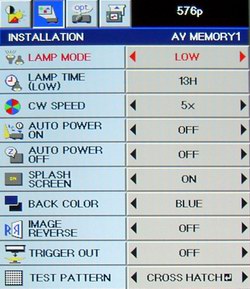
Of further interest in this category are the Lamp Mode, the Image Reverse option and the integrated Test Pattern, which makes the optical adjustments to sharpness and zoom a whole lot easier with placement of the projector.
The third category contains, among other things, further options to adjust to the input signal (for instance Black Level with the "Setup" function). Of special interest here is the "Cinema Mode", which (hopefully) pertains to an improved de-interlacer in the HC3100.
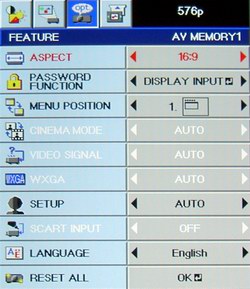
The fourth category does not offer any new functions compared to the HC3000 & company, however it is structured better. The Overscan option for instance has been moved from a sub-menu to the first level now, where it belongs. Less used functions like for instance the "Blanking" function are conveniently gathered under "User".
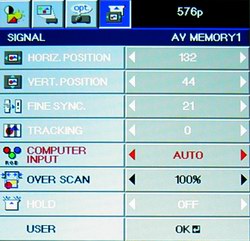
The mage position can also be changed
The control concept of the HC3000 at that time was very convincing already
because of its numerous functions, which were also presented clearly and
intuitively in the menu structure. This was retained, and in the case of the
HC3100 even expanded with a few options. The projector now offers control
options that leaves almost nothing to be desired, except for an even more
detailed color management system for adjusting the color space.
In addition, the improved remote control offers much more comfort, but even the little HC1100 version supports the operation of the projector just fine.
3. Image Quality
In the picture section it will be very interesting to see how much improvement in image quality the HC3100 will offer compared to its predecessor, and how the HC1100 can keep up. As in the previous chapters we will examine both models at the same time, and explain differences between them if there are any.
3.1 Screendoor / Pixel structure (Know How Link here)
As in the HC3000, the HC3100 uses a DMD with a native resolution of 1280 x 768 pixels, but this time with a contrast enhanced DarkChip 3 version. In video operation, only 720 of the 768 lines are used (the remaining pixel lines can be used as digital Lens Shift), so on the screen the DLP typical, practically non-existent Screendoor effect is displayed.
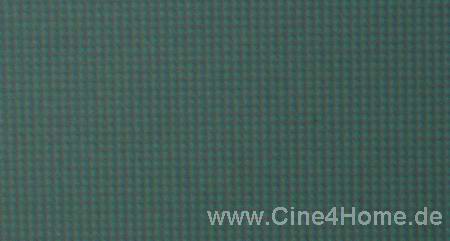
The pixel structure of the HC3100 in close-up and from a short distance
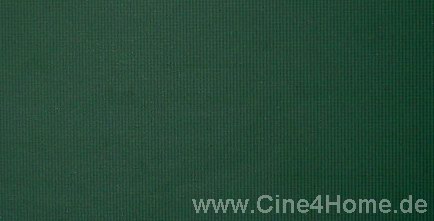
With its high fill factor of over 80%, the pixel structure is invisible from normal viewing distances. The same goes for the HC1100 by the way, which displays the small HD resolution of 1280 x 720 pixels on the screen.
3.2 Color Space (Know How Link here)
Mitsubishi already made a big effort with the previous model concerning color space. The big advantage compared to other DLP projectors in its price range it offered primary colors which were tuned to the video standard, and which are very important for the right color mixture. Despite the changed color wheel these good results have been retained with the HC3100 and also with the HC1100.

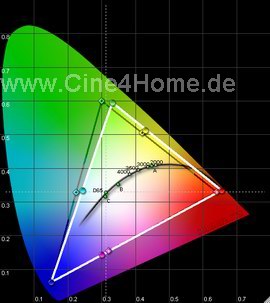
Left: Color Space of the HC-3100, right: Color Space of the HC-1100
The diagrams above show the respective Color Spaces of the projectors (white triangle) in relation to the HDTV standard (dark triangle). The tuning to the primary colors is exemplary, only Green misses the mark slightly. Apparently this was optimized with NTSC in mind. This Color Space is exemplary for DLP projectors and will not be reached by the competition in this price range.
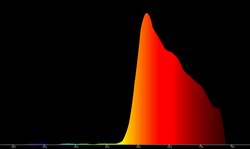
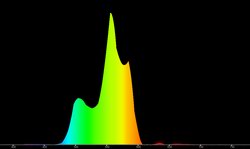
Spectrum analysis of Red, Green, Blue und White

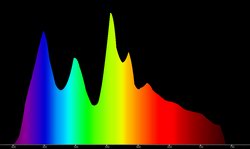
And the technical designers managed to improve on another aspect compared to the HC3000: while the old model clearly showed deviations with regard to the secondary colors (Yellow, Magenta, Cyan), the HC3100 as well as the HC1100 are perfectly tuned to the video standard regarding these mixed colors. This suggests an equally exact alignment of the Color Temperature, which we will examine in the next section.
3.3 Color Temperature (Know How Link hier)
One of the larges deficits with the Mitsubishi DLP projectors has been the Color Temperature, which always showed a lack of Red and at the same time an excess of Blue, resulting in an image representation that was too cool. Only a calibration with measuring instruments remedied the situation, costing some time and light output. On numerous occasions we have given feedback to the manufacturer regarding this issue, and our prayers have been answered: as described under Technology, the color wheels of the new models have been adjusted optically to the necessary D65 color temperature of white. The result of this should not only be that these models are well tuned to D65 from the factory, but also that they come close to their maximum contrast with this color tone. We only believe what we can technically examine for ourselves, and in the case of the HC3100 the designers have not promised too much.

The diagram above shows the factory setting of the HC3100, without us making any manual adjustments. Only a very slight excess of blue remains visible, which however does not annoy in the displayed picture. More can not be expected from default factory settings, especially not in this price range.

The Color Temperature is almost exactly at 6500K / D65
The HC1100 also gains from the new color wheel, its Color Temperature was about just as good in our test. Its slight lack of Red is also in the non-visible range.
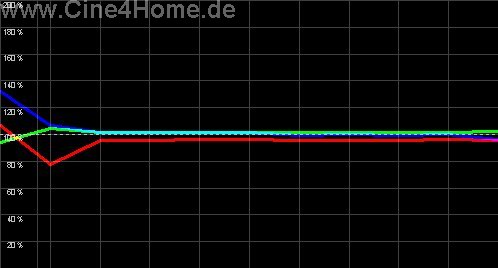
Color Temperature of the HC1100
More and more manufacturers are complying with the video standard regarding Color Temperature, and with both the HC3100 and the HC1100 the devise is: switch on and enjoy. And that is the way it should be, because a user can not be expected to become and expert and purchase expensive measuring equipment all to get the right image on the screen. But for those who want to tune the projector to perfection, more than enough parameters are at the users disposal:
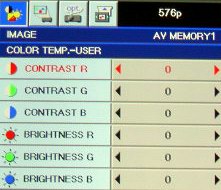
RGB menu for bright and dark
With some know-how and measuring equipment the Color Temperature can be tuned to the video standard to an astonishing perfection.
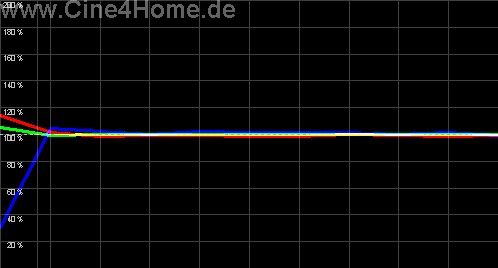
Very good adjustments in only a few minutes
Regarding colors the HC3000 is clearly below the performance of its successors. While its predecessor needed extensive adjustments for an accurate picture reproduction, both the HC3100 and the HC1100 reach almost perfect results right out of the box. A Color Space that is well tuned to the video standard, with good primary and secondary colors and an almost exemplary Color Temperature, all these are rewarded with the picture representation: both projectors show an absolutely exemplary color representation. The new Mitsubishi models bravely succeed in reproducing the cinema originals.
3.4 Black level, Contrast, Brightness (Know How Link here)
Next, we come to a very exciting theme: the new Color Wheel has already provided for a definite improvement concerning Color Space and Color Temperature (as we just explained). But did Mitsubishi also succeed in improving contrast while maintaining the right color representation? We have examined this with both models, let's start with the HC3100:
The HC3100 has two advantages compared to its predecessor, which could lead to an improvement in Contrast: on one hand it uses the already mentioned D65 optimized Color Wheel, on the other hand it makes use of a DC3-DMD, the newest generation which should also exhibit better reflection characteristics. It is also surprising that the projector is still to offer a very high maximum brightness, 1000 ANSI Lumen as indicated by the manufacturer. With the additional Adaptive Iris in front of the optics (see chapter Technology) and the Lamp Mode selection (either "Low" or "High"), Contrast, Black Level and Maximum Brightness can be influenced. We have gathered all our measured data in a table:
HC-3100 - Measurements "D65 / 6500K "
Mode |
Light (Low) / Lumen |
Light (Hi) / Lumen |
Contrast |
| Iris closed | 490 |
620 |
3000:1 |
| Iris open | 780 |
970 |
2300:1 |
As one can see, the values of our HC3100 review sample are clearly higher than
with its predecessor HC3000. It appears that the new DMD and above all the
optimized D65 Color Wheel do a good job, and will indeed allow almost maximum
contrast at accurate colors. Compared to the HC3000 the gain is almost 30%, a
difference that is hard to ignore. The brightness is suitable for image widths
of up to 3 meters and even beyond (depending on Lamp Mode). Because of the many
adjustment options, a very good maximum brightness with equally good black level
can be achieved in just about every room.
Now we go on with the HC1100: as already explained under Technology, it does not use an Adaptive Iris and on the inside "only" a common DC2 chip operates. Nevertheless the measurements are exemplary for this price range.
HC-1100 - Measurements
Mode |
Light (Low) / Lumen |
Light (Hi) / Lumen |
Contrast |
| D65 / 6500K | 650 |
800 |
1800:1 |
| Max | 750 |
950 |
2200:1 |
With a maximum contrast of 2200:1, a contrast ratio of 1800:1 remains with
correct colors at a brightness of 650 to 800 Lumen. These results allow for a
very good illumination and high color depth in most circumstances, only with
regard to black level the HC3100 and its predecessor HC3000 are clearly better
than that of the HC1100.
With regard to contrast and brightness, both projectors show good results, even when the HC3100 is clearly ahead as expected. Its flexible concept allows optimum adjustment to every room condition. Both models achieve an especially good image depth in normal movie operation, which can be attributed, among other things, to the high in-picture contrast of over 500:1. Despite bigger On\Off contrast ratios in part, the LCD technology can not keep up here so far.
3.5 Luminance tracking / uniformity (Know How Link here)
From the beginning, we expected good results regarding gamma distribution, because its predecessor already showed excellent results with its factory presets. These expectations were confirmed, so that this section could be copied almost without alteration:
Color Space and 6500K adjustment have a similar relationship as Contrast and Gamma distribution do. The Contrast ratio represents the dynamic range, the gamma distribution provides the appropriate use of that range. The ratio between incoming signal and outgoing brightness corresponds to a curve of about 2.2 with current DVD mastering. Both the HC3100 and the little HC1100 appear to have a very balanced brightness curve in Cinema mode:
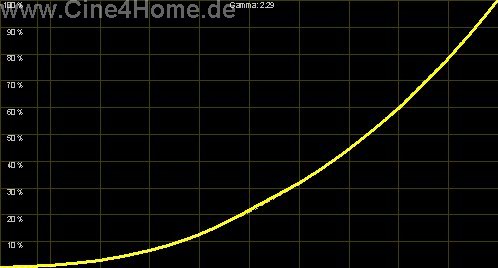
Above: HC3100 (2.29), Below: HC1100 (2,3)
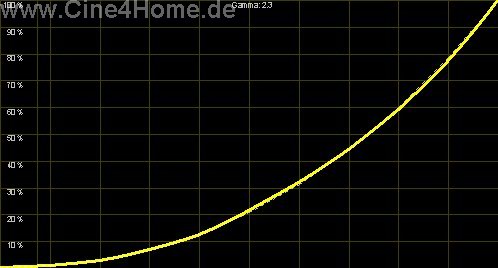
The diagram above shows the factory settings of the "Cinema" preset with a rise of 2.29 and 2.3 respectively, which is even in all ranges. This factory preset provides for an appealing picture composition in almost any room. The coloration in dark scenes is at a good level, even dark details remain recognizable. And even in bright scenes no details appear over-emphasized, but retain their natural image depth.
Those who have an especially optimized home theater room with dark walls and little scattered light, could operate the projector with a little steeper gamma curve (up to 2.5), which provides in a subjectively more deep image. The tried and trusted gamma equalizer in the Picture menu allows such a tuning, quickly and accurately.

The gamma equalizer of the HC3100
For user defined gamma curves, two different memory banks are at the users disposal. First, the reference curve can be selected, which for normal home theater applications would be "Cinema". With the aid of the equalizer the gamma curve can be adjusted in three separate sections: "Low" influences the dark ranges, "Mid" the middle part and "High" the brightest. This function of the equalizer proved to be very accurate and easy to operate in our practical test. With the aid of measuring instruments, steeper and at the same time homogeneous gamma curves could be realized in just a couple of minutes. The experienced user can optimize the HC3100/HC1100 to his personal preferences and room conditions by using these excellent adjustment options.
In addition to the "Cinema" mode and the gamma equalizer, both beamers offer two other presets: "Video" and "Sports". The first one is tuned to a gamma curve of 2.2, the last one is tuned for sports representation and not suitable for dark rooms.
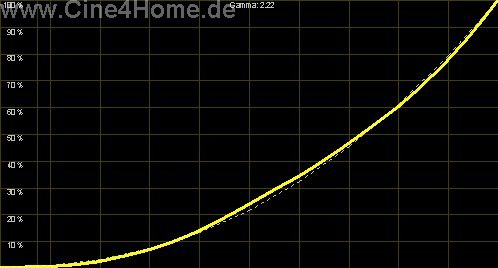
Above: Gamma Video, Below: Sports
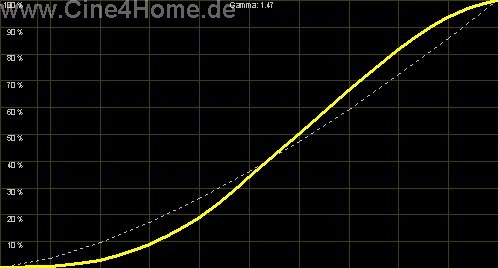
The brightness curve in the "Sport" mode is very steep, in order to brighten most portions of the image and thus make them visible even when there is ambient light in the room. This brings the picture very close to Clipping, which however is often accepted with Live transmissions. While not recommendable for a movie night, the "Sport" mode can be useful with many a sports event with friends.
As with its predecessor, the Mitsubishi HC3000, both the factory settings and the additional adjustment possibilities are exemplary: here clarity and functionality are successfully interconnected, which especially with DLP projectors is still a rarity these days. With all these characteristics in combination with the good contrast ratios, both models are able to display a deep and realistic image. The picture composition is as the filmmaker intended, both in bright and in dark scenes. Because of its high on\off contrast the HC3100 manages to achieve even more spaciousness in dark scenes compared to the HC1100, due to its better black level.
3.6 Sharpness / Brightness uniformity / convergence (Know How Link here)
We could see no technical changes in the structure of the optics. Also, both models apparently use the same optics, so they show the same results to a large extent.
The optical sharpness of the image can be considered good, and is even up into the corners. Even when operating the projector with a PC no loss of sharpness can be seen on the desktop.
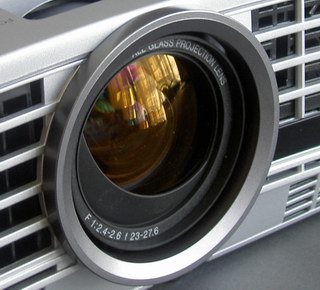
Important for the image definition,
the optics
We already criticized the HC3000 for this, and unfortunately this was not corrected with the HC3100 / HC1100: slight color fringing (Chromatic Aberration) which show up in certain zoom ranges.
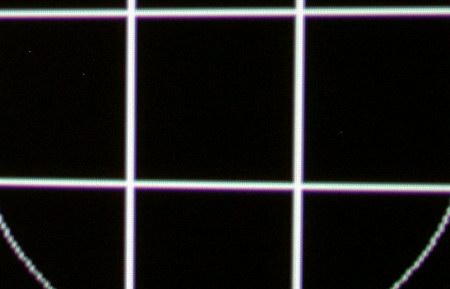
Slight convergence shifts by the optics
The slight Red seams are subtle enough however not to be a serious annoyance during movie operation. And with small zoom ranges the convergence is almost perfect.
The Adaptive Iris of the HC3100 still produces minimal loss of brightness towards the edges of the picture, but in normal movie operation these are almost invisible. With full screen PC projections they could become visible however. The HC1100 does not have an Adaptive Iris, so here it behaves like an HC3100 with open Iris.
Altogether the optical characteristics of the new models can be evaluated with "Good", as with its predecessor. Slight color fringing and a not entirely perfect illumination are present, but in such a way that they will not seriously disturb the picture.
3.7 Overscan (Know How Link here)
Concerning Overscan, there was not much to improve upon compared to the HC3000, the system consisting of variable Overscan & Blanking was already perfect. It was copied with both the HC3100 and the HC1100. The Overscan is adjustable in small steps from 0 pixels (no Overscan) to 40 pixels (large Overscan).
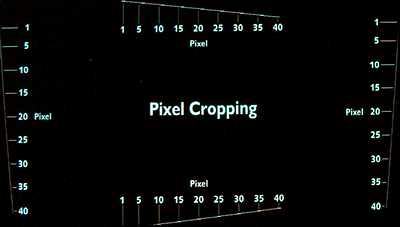
The Overscan is adjustable from "Off" (above),
to "Large" (below).
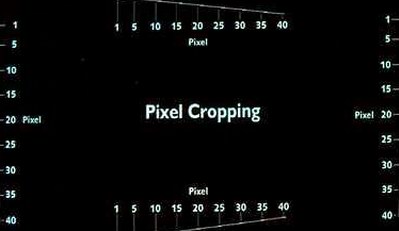
Additionally, every edge of the image can be separately provided with a Blanking using the "Shutter" function. This function is especially practical when additional but annoying signals are visible above or below the picture (VideoText for instance). These kinds of "static" can be elegantly eliminated without using Overscan.

Shutter function, separately for each edge
Only very few of the competing models offer such a versatile menu for adjustment to the source signal.
3.8 Picture Noise / False Contour / Banding (Know How link here)
Picture Noise and False Contour (ghost images with fast movements in dark areas) will remain to be artifacts with single chip projectors for some time to come, every DLP fan has to live with them. But the manufacturers are always seeking improvements. Using the DDP3020 control chip in combination with the LVDS DMD, and a faster signal processing (10 bit!) the mentioned artifacts were already visibly reduces with the HC3000. The results are the same with the new models:
They convinced us with an absolutely very good color resolution, which does not show any annoying reductions in movie operation anymore. Even fine color transitions are accurately displayed on the screen, the annoying "Banding" is hardly if at all visible. Even the annoying False Contour effect is reduced, even if it is not eliminated completely. What remains is a slight Noise with brightness's up to 20%, which however is not annoying at all from appropriate viewing distances.
However, all these observations refer to the more common, quadruple color wheel speed. In our earlier HC3000 review we have already explained that a faster color wheel speed could have a negative impact on color accuracy and DLP artifacts. If the HC3100 is switched to five-speed color wheel mode, the increase of False Contour, Banding and Flickering is noticeable in critical scenes. All these effects remain at an acceptable level, typical for 5\6-speed color wheels, but finally the user has to decide where to place his personal emphasis.
3.9 De-Interlacing (Know How Link here)
A weakness of the Mitsubishi DLP projectors up to now has been the de-interlacing, they all did not have a film mode suitable for PAL. Something has changed here actually, however only with the larger HC3100 model.
Film material
With movie material (24 frames per second) two half-images are derived from a single cinema image. To obtain the optimum representation quality when projecting the movie, the two matching half-images must we woven together again to form the full cinema frame. This process is known as "Film mode". In the Picture menu the function "Cinema mode" is present, which according to the manual should also do the 2:2 Pull Down process. In the case of the HC3100 it does: the projector reliably reconstructs the original movie frames and remains stable in its Film Mode. All our difficult test movie scenes it passed without much effort, only extremely rarely it switched to video mode for a short time. However, with signals that contain only little color information (low luminance) some sort of "interlace flickering" is visible.
The HC1100 is a different story: it shows the same weakness as the HC3000 with regard to film mode, even with very little movement the de-interlacer looses its rhythm and causes loss of detail. This is unpleasant, but can be corrected with a cheap Progressive Scan DVD player (preferably with HDMI output) for DVD material.
Video material
Video material consists of image material that has been recorded with the usual video- and television cameras: sports, shows, interviews etc. Every half-image is a snapshot in time. This results in 50 images per second, each with a vertical resolution of only 288 lines. The projector however operates progressively all the time (with higher resolution). The missing lines in the image are "calculated" by the de-interlacer.
With video sources, which constitute the majority of television programs, both new Mitsubishi's perform this task well, as did their predecessor. Using Motion Adaptive processing, the static parts of two consecutive half-images are woven together, the even lines from one half-image, the uneven lines from the other, to form a full image. With moving picture elements this method does not function properly, because the half-images do not accurately fit together due to the movement difference between frames. Moving picture elements are scaled up to the higher resolution by interpolation.
The result with representing video material is good considering the processing. It is almost free of annoying line flickering and shows only a slight unsharpness with moving elements. That makes the HC3100 and the HC1100 well suited for the occasional TV event.
3.10 Details / Scaling / Sharpness
Concerning the de-interlacing some differences between both new models were apparent, but with regard to signal processing and scaling our test results are about the same again for the most part:
3.10.1 Signal Processing
Analog / Digital
Characteristic for good signal processing is the conversion of source signals, whether digital or analog, to data that is usable for the projector, without adding annoying double outlines to the picture. The HC3100 was improved in this respect somewhat compared to the HC3000, it now only shows very slight double contours which are not visible in movie operation.

The HC1100 however behaves like its predecessor, the HC3000: out of the box it shows somewhat more pronounced double outlines, which however can be reduced with the sharpness function.
3.10.2 Horizontal scaling
Analog / Digital
The 720 pixels of our PAL standard have to be scaled up to the native 1280 pixels of the projector by the internal scaler, without the resolution conversion leading to disadvantages (linearity fluctuations or interference) in the picture representation. These results are the same for both models:
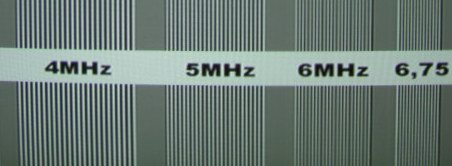
As can be seen in the picture above, the scaling is very precise and even: the difficult test pattern is accurately converted to the native resolution of the projector, without introducing disturbing interferences in the picture. Only in the 6 MHz range slight fluctuations in linearity can be seen. With such a scaling the original details in DVD recordings are retained, even fine structures and small writing will not show visible unsharpness.
Exemplary is the color resolution of the projector: with both analog and digital feeds the projector shows fine details without loosing color or brightness.
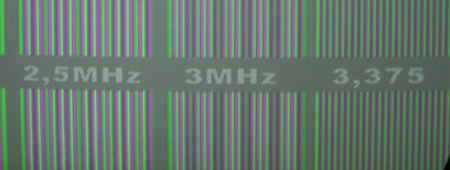
However, this only applies to analog signals and digital RGB signals. Because with a HDMI YPbPr feed we met the "Chroma Bug" again, which rears its ugly head ever more lately. It switches the color columns, which leads to fringing in details with strong colors.

Erroneous Chroma interpolation with digital YUV feeds
This effect, which we also observed with the Optoma HD72i and the Hitachi TX200, was unfortunately not taken care of with the new models compared to their predecessor HC3000. But fortunately there is a "workaround" by the use of HDMI-RGB, which can be adjusted on every modern DVD player. When using RGB, the color information is displayed correctly.
3.10.3 Vertical scaling
Vertically, the resolution also has to be converted from 576 lines (PAL) to 720 lines.
Analog / Digital
Vertically, the scaling electronics of both models shows good results also. In the picture below it is visible how the frequently occurring vertical DVD resolutions are displayed without many interferences.
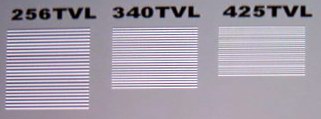
This is especially beneficial with vertical camera movement, because inadvertent Moiré effects will remain absent.

Even single-line details are converted sharply
Because of the good scaling (both horizontally and vertically) with accurate resolution the picture appears pleasantly sharp in movie operation, without appearing artificial. Details appear as they are recorded on the DVD. Thus the picture quality is influenced only by the picture medium, not the projector.
3.11 Rainbow / Rainbow Effect (Know How here)
Home Cinema fans sensitive to rainbows had to walk around the HC3000 in a big circle up to now. With its quadruple color wheel speed (200Hz) it offered a good average, but many different models showed better values, at least in the higher price ranges.
The designers of the HC3100 took this to heart and have now integrated a five-fold color wheel. This makes the RGB repetition frequency high enough (250Hz) to noticeably decrease the rainbow effect. Only very sensitive eyes will find the effect disturbing with the HC3100. But the "Flexibility" principle was also kept here with regard to color wheel speed: as we already mentioned, the color accuracy suffers from higher color wheel speeds. The faster the color wheel, the less time there is for the digital color modulation, the less accurate the colors. For those who are insensitive to rainbows and want to enjoy all the advantages of the DDP3020 color modulation, it is possible to simply switch the HC3100 into quadruple (200Hz) color wheel mode.
The agony of choice does not apply to HC1100 users however: as its predecessor HC3000 it is fixed to a four-fold color wheel speed, a five-fold option as with the HC3100 is not present.
Remark:
- Sensitivity to the rainbow effect is very personal. This is why we recommend to test your sensitivity to the rainbow effect yourself before buying a projector.
3.11 HDTV Picture Impression
Even now the HD market in Germany is disputed: a moderately successful Pay-TV broadcaster excluded, hardly any television company in this country has made technical provisions for the signal of the future (HDTV), let alone broadcasted one. Apparently conservative economic measures are more important than the service to the customer. An observation that unfortunately in this country does not apply only to television broadcasts.
And even with pre-recorded media, it is unclear at the moment which choice is the better one: HD-DVD or Blu-Ray. In the next few months however the format war will be raging here also. And this is a good this, especially for HC3100 / HC1100 owners, because only then the HD-ready beamers show their full potential with regard to image quality.
We have already tested the media of the future (see our big HD-DVD / Blu-Ray special (only in German)) in combination with the new Mitsubishi beamers:
Both projectors sharply convert the incoming Full HD (1080i) signal to their native resolution of 1280 x 720 pixels. A certain loss of sharpness is to be expected of course compared to the full 2 mega pixel HD resolution, but the detail sharpness (which in the case of the HC3100 is particularly free of double outlines) shows an image which has a new dimension compared to a normal PAL image. In combination with the few digital artifacts of the projectors, the HD material is appropriately displayed and free from picture disturbances, as hardly seen before up to now. This makes watching a movie fun, as the user has nothing to complain about, at least not as long as the source signal permits. In any case, the projector is not the bottleneck, either in the case of the HC3110 nor with the HC1100.
4. Conclusion - HC3100 vs. HC1100
The results of this somewhat elaborate combined test is surprising, but then again it isn't. It is surprising to see how well the HC1100 fares in this review, especially considering its very attractive price. The projector not only presents a good entry in the world of home cinema for both PAL and HDTV viewing, but also is ahead of many competitors in this price range (and beyond). Less surprising is the fact that the HC3100, by making use of the more modern technologies compared to the HC1100, is even better in some areas. It is a pleasant surprise to see that almost all remaining deficits we have unveiled in the HC3000 review, have been consequently improved or repaired in the HC3100
Now in its third generation, the model is very convincing in its picture representation as no other projector in this price range. The large Color Space (thanks to the optimized color wheel) now clearly shows better tuned secondary colors, and even the D65 Color Temperature is accurate out of the box now. This is where its predecessor had its biggest problems. Out of the box the projector is capable to reproduce the colors of the cinema accurately and natural, like almost no other DLP projector.
The brightness distribution is at a good level from the factory, as it was with the HC3000, no additional correction is necessary here. But those who have special requirements, the Gamma equalizer can produce any kind of brightness distribution needed or wanted. The contrast with correct color representation was improved also with the HC3100 (about 3000:1), so that especially dark scenes show even more coloration and image depth. Hardly any scene is able to embarrass the picture presentation.
The signal processing is very dependable concerning scaling and detail representation, with both analog and digital feeds. We were particularly impressed with the natural quality if the image, which in no way seems digitally over-sharpened. The signal processing was improved again, resulting in even less double outlines now.
Unchanged are the good optical sharpness of the projection optics, which unfortunately can introduce slight shifts in convergence in the picture depending on zoom.
The good picture characteristics are rounded off by a very versatile Picture menu, which incorporates all relevant functions and is good for both beginners and advanced users. Especially the adjustable Overscan and the Blanking function should be mentioned as positive innovations.
Evaluation Picture overall : 1,75 (Good +) |
|
Black Level & Contrast |
1,4(Very good -) |
Gamma |
2 (Good) |
Sharpness & Interpolation |
2,1 (Good) |
Color Space & Color Temperature |
1,5 / 1,7 |
De-Interlacing |
2,0 (Good ) |
Other aspects |
1,7 (Good +) |
(all evaluations refer to the respective kind of projection and the current state of the art. Therefore, a direct comparison between systems is only possible under certain conditions)
The "Positive" list of the image characteristics ended here with the HC3000, but with the HC3100 it goes on. In addition the projector convinces with a really very well working de-interlacer, which now processes incoming PAL movie material well. And also the now selectable five-fold color wheel speed allows DLP enjoyment for those with sensitive eyes. In other words: the HC3100 hardly shows any annoying weaknesses. Clearly, we do have to criticize the "Chroma Bug" with a digital YUV source signal, this is unnecessary in the second generation of a machine.

Now lets go to the HC1100: as the review showed, the small projector astonishingly achieved the same or approximately the same level of its bigger brother in many areas. Technically it can not keep up in other areas though: contrast is one of these, which because of the non-present Adaptive Iris and the older DMD chip version is not as high and as flexible as that of the HC3100. Although it does offer an impressive image depth thanks to the DLP technology, it does appear to be a little more "foggy" than its bigger brother in dark movies or scenes. Furthermore, it does not offer a variable color wheel speed, so that its rainbow characteristics should be examined in peace at a trusted dealer. The signal processing is similar to the HC3100, where clearly reductions had to be made concerning de-interlacing. For movie representation a progressive input signal is a must.
Evaluation Picture Overall : 2 (Good) |
|
Black Level & Contrast |
1,8 (Good +) |
Gamma |
2 (Good) |
Sharpness & Interpolation |
2,2 (Good -) |
Color Space \ Color Temperature |
1,5 / 1,8 |
De-Interlacing |
2,6 (Satisfactory. +) |
Other aspects |
2,2 (Good -) |
Exemplary for the price range of the HC3100 and especially that of the HC1100 is the build quality. Compact dimensions, solid components and appealing design make these projectors compatible to every living room. In addition the ventilation system was optimized to such an extent that it does not disturb movie operation in any way.
The operation with graphic symbols and text is understandable and technically exact, but nevertheless clear and intuitive. The reliable remote control with its large range ensures trouble-free operation. Especially the new and larger variant of the HC3100 is very convincing. The offered functions with both models cover everything that is required for adjustment to the signal source and room characteristics.

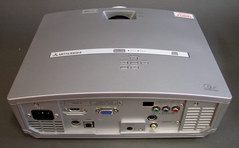
The placement characteristics were not improved unfortunately: a small zoom
range, the absence of an optical Lens Shift (with the HC3100 a 48 pixel digital
Lens Shift is present nevertheless), and the large offset (vertical displacement
compared to the optical axis) make a large amount of pre-installation room
planning necessary.
The placement flexibility of the LCD competition, which allows placement of some models just about anywhere in the room, is not reached as before. Especially the room height should be considered with the HC3100 / HC1100, to avoid diagonal placement of the projector and digital trapezoid correction. Again we would like to mention that all DLP projectors allow for less placement flexibility because of their "native" design. More flexibility, which makes an entirely different optical path with expensive glass prism necessary, is hardly possible in these price ranges.
Both models managed to impress us in our elaborate testing procedures. Our personal favorite is the HC3100, which should not come as a surprise. It is beautiful to observe how the engineers took care of the few points of criticism concerning its predecessor and managed to improve on them in this new generation. What came out of all of this is an in every way well developed product, offered at an attractive price, which the owner should guarantee many years of home cinema joy. Considerable weaknesses are too few to mention. And even the HC1100 profits from its successful predecessor, as in many areas the new little one is the same as the HC3000. Understandably, some of the more expensive components, as for instance the Adaptive Iris or the DMD chip, were changed or deleted altogether. But for those who are searching for a cheap but at the same time qualitatively convincing entry into the world of large screen home cinema, the HC1100 is wholeheartedly recommended.
5. Evaluation
+ Good build quality, compact dimensions
+ Strong colors, large color space
+ Almost perfect D65 tuning out of the box
+ Many well thought thru adjustment options
+ Few DLP artifacts
+ Good color resolution
+ Quiet operation
+ Five-fold color wheel speed (HC3100 only)
+ XGA representation without compression (HC3100 only)
+ 3000:1 contrast with accurate colors (HC3100 only)
+ De-Interlacer with functioning PAL Film mode (HC3100 only)
+ Adaptive Iris (HC3100 only)
+ Digital Lens Shift (HC3100 only)
- Placement flexibility
- Slight color seams (depending on Zoom)
- High vertical offset (not adjustable with the HC1100)
- Only one digital input
- Chroma Bug with HDMI YpPbPr feed
- No well functioning PAL Film mode of the de-interlacer (HC1100 only)
- Possibly rainbow effect with sensitive viewers (HC1100 only)
- Lesser color accuracy in five-fold color wheel speed mode (HC3100 only)
Evaluation Overall : 1,6 (Good+) |
|
Equipment |
1,8 (Good +) |
Operation |
1,7 (Good +) |
Technology |
1,8 (Good +) |
Picture |
1,75 (Good -) |
Price \ Performance |
1,2 (Very Good -) |
(all evaluations refer to the respective kind of projection and the current state of the art. A direct system-spreading comparison is only conditionally possible therefore!)
HC-1100
Evaluation Overall : 1,9 (Good) |
|
Equipment |
2 (Good) |
Operation |
1,8 (Good +) |
Technology |
2,2 (Good -) |
Picture |
2 (Good) |
Price \ Performance |
1,2 (Very Good -) |
28. August, 2006, Cine4Home
Translation: Den Walterfang (September 17th, 2006)
6. Technical Details (from Manufacturer):
- System: 1280x768(DarkChip3TM) (HC3100) / 1280x720(DarkChip2TM) (HC1100)
- Resolution: 1280*768 (HC3100) / 1280x720 (HC1100)
- ANSI Lumens: 1000
- Contrast: 4500:1 (HC3100) / 3000:1 (HC1100)
- Lamp: 200w
- Lens (f, mm): 23 ~27.6
- Keystone: Yes
- Fan noise: 25dbA (Low mode)
- Color Wheel: 5x / 4x (HC3100) / 4x (HC1100)
Compatibility
- Computers: VGA, SVGA, XGA, SXGA
- Video: PAL,SECAM,NTSC,NTSC4.43,PAL-M/N, HDTV (480i/p, 576i/p, 1080i, 720p)
- Horizontal Freq.: 50-85kHz
- Vertical Freq.: 15-80Hz
- HDReady: Yes
Terminals
- VGA: 1
- HDMI: 1
- Component: 1
- S-Video: 1
- Composite: 1
- USB: 1
- RS-232: 1
General
- Remote
- Dimensions: 310mm(W) * 100mm(H) * 245mm(D)
- Weight: 2.9kg
- Power Supply: 100-240VAC, 50/60Hz
- Power Consumption: 280watts
